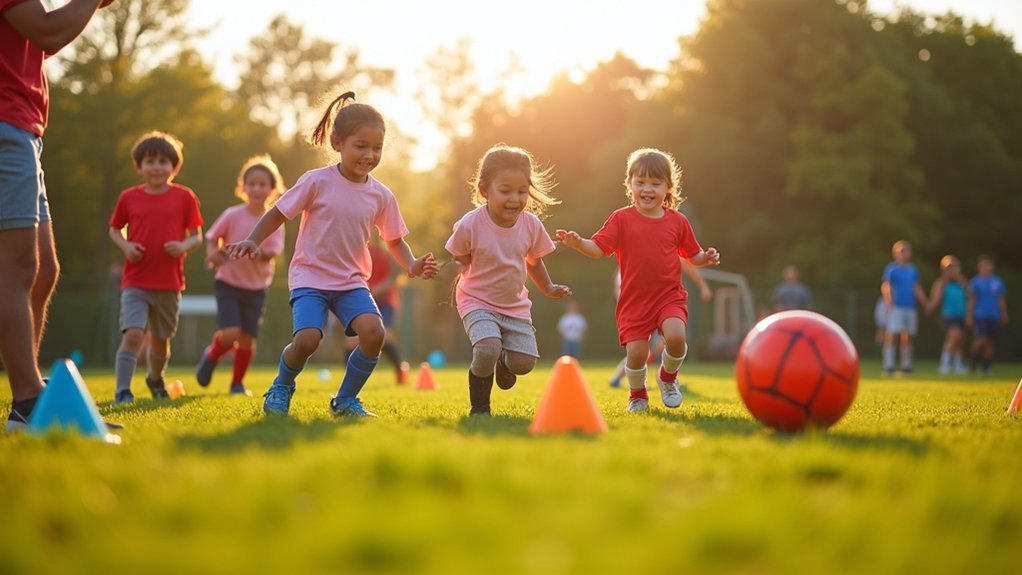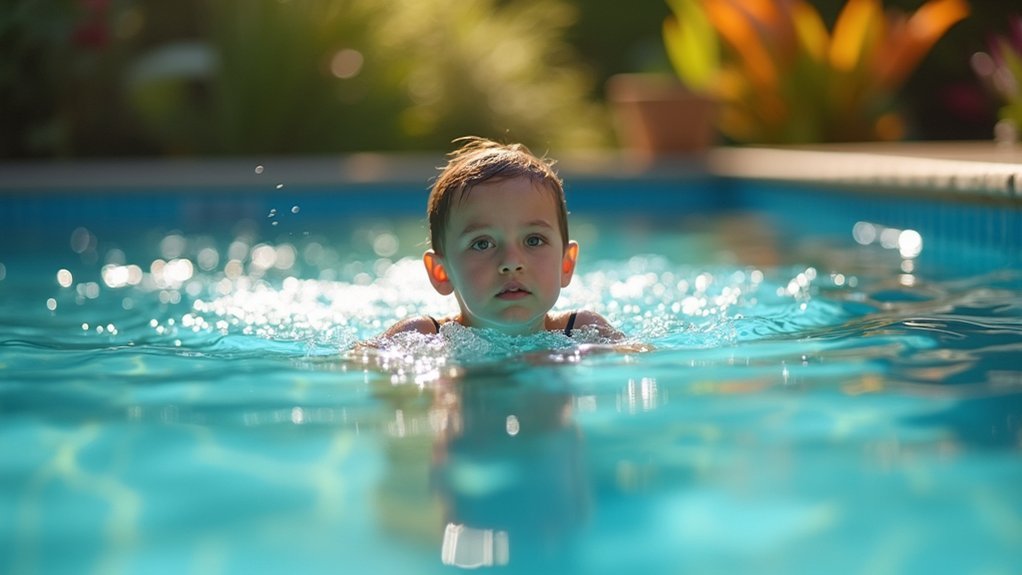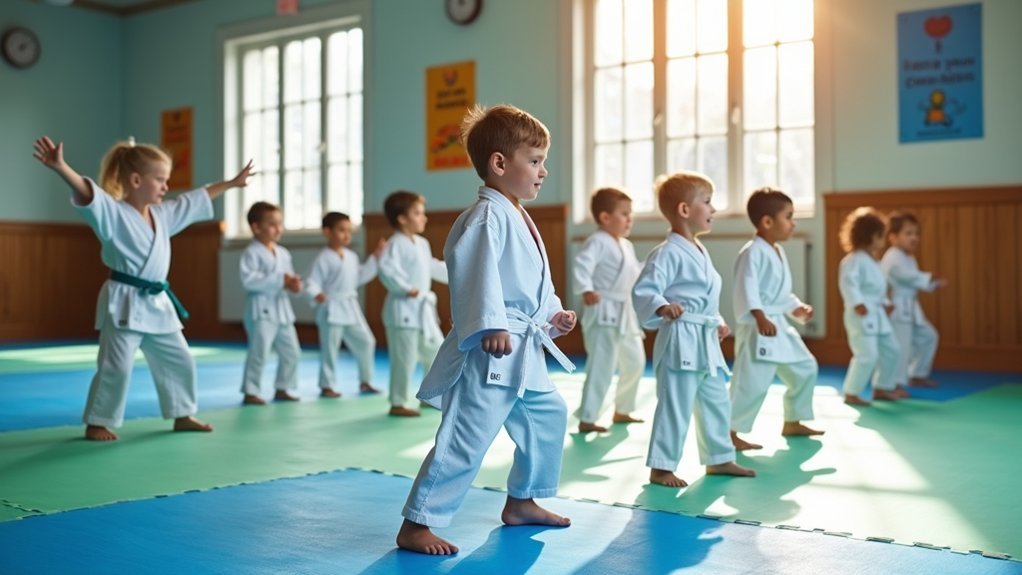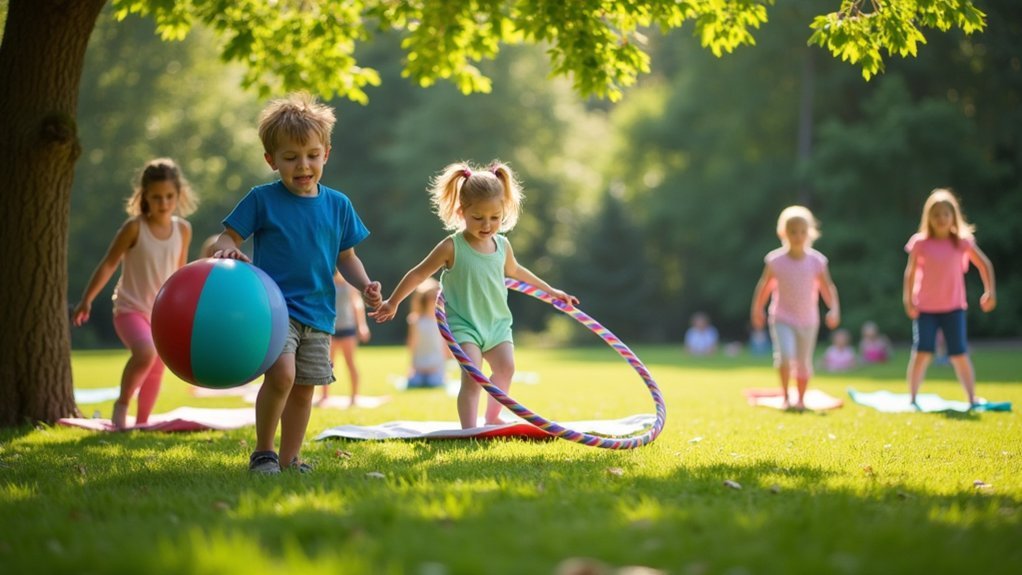Children with autism often thrive in sensory-friendly sports that minimize overwhelming stimuli while building physical skills. Swimming offers calming water pressure, while individual track events provide predictable routines with limited social demands. Martial arts develops focus through structured patterns, cycling creates rhythmic sensory regulation, and adaptive versions of traditional sports use specialized equipment in quieter settings. These activities not only accommodate sensory needs but can transform social confidence and emotional regulation as your child develops new abilities.
5 Sensory-Friendly Sports for Autism Success

While traditional sports settings can overwhelm children with autism, sensory-friendly alternatives offer a path to meaningful athletic participation. These modified environments minimize jarring stimuli like bright lights and loud noises that often trigger sensory issues in autistic children.
Sensory-friendly sports create accessible environments where autistic children can thrive athletically without overwhelming stimuli.
You’ll find these programs use specialized equipment—softer balls, quieter venues—that accommodate each child’s special needs while promoting engagement. Research confirms that participants develop essential social skills through structured team interactions and improve communication skills in a supportive setting.
The predictable routines built into these sports programs provide security for your child, reducing anxiety that might otherwise prevent participation.
Organizations like Special Olympics offer tailored activities specifically designed for sensory-sensitive athletes, creating inclusive spaces where your child can build confidence while enjoying physical activity alongside peers.
Understanding Sensory Processing Challenges in Sports Environments
Sensory processing challenges can turn typical sports environments into overwhelming battlegrounds for your autistic child, with fluorescent lights, referee whistles, and crowded spaces triggering fight-or-flight responses.
You’ll notice your child may struggle with certain textures of equipment or become distressed by unexpected physical contact that’s common in team sports.
Sensory Challenges Explained
Understanding how the brain processes information lies at the heart of adapting sports for autistic children. When you’re working with children on the autism spectrum disorder, recognizing their unique sensory processing patterns is essential.
Their brains may register everyday stimuli—like a referee’s whistle or gymnasium lights—as overwhelming or painful. This sensory overload can trigger fight-or-flight responses, making participation difficult or impossible. Children might cover their ears, avoid eye contact, or withdraw completely from activities.
What seems like behavioral issues often stems from genuine physical discomfort. Creating supportive sports environments requires identifying each child’s specific triggers and thresholds. Some may be hypersensitive to sound but comfortable with visual stimulation, while others experience the opposite.
Adapting Athletic Environments
Creating a sensory-friendly athletic environment requires thoughtful modification of spaces that many take for granted.
You’ll need to evaluate how sensory processing challenges affect autistic athletes by reducing ambient noise, softening lighting, and implementing visual supports like picture schedules.
Incorporate adaptive equipment such as noise-canceling headphones and sensory-friendly uniforms to enhance comfort and participation.
Designated quiet zones offer essential retreats where athletes can manage sensory overload and return when ready.
Training your staff to recognize accommodation needs fosters an inclusive atmosphere where autistic individuals feel understood and supported.
These environmental adaptations aren’t merely nice-to-have features—they’re fundamental for ensuring autistic athletes can fully engage in sports without the distress that traditional, overwhelming environments might cause.
Swimming: The Ultimate Low-Sensory Physical Activity

Swimming offers your child with autism a therapeutic buoyant environment where their body weight feels lighter, reducing sensory overload while building essential motor skills.
You’ll notice how water’s natural resistance creates a gentle, encompassing pressure that many autistic children find calming and organizing for their nervous system.
Your child can progress at their own pace in aquatic activities, starting with simple water familiarization before advancing to stroke development as their confidence and abilities grow.
Buoyant Therapeutic Environment
While many sports present sensory challenges for children with autism, water offers a uniquely supportive environment that can transform physical activity into a therapeutic experience. The buoyant therapeutic environment naturally supports your child’s body, creating a safe space to develop motor skills without fear of falling.
- Water’s gentle pressure provides calming sensory feedback that reduces anxiety
- Buoyancy supports your child’s movements, making coordination easier to achieve
- Structured swimming routines create predictable patterns that comfort autistic children
- Visual aids in swim classes help clarify instructions and expectations
- Small group settings foster natural social interaction with peers in a low-pressure environment
You’ll likely notice improvements in your child’s physical fitness and emotional well-being as they gain confidence through regular swimming sessions.
Individualized Aquatic Progression
When your child steps into the water, a truly unique sensory experience begins that can transform their relationship with physical activity. Swimming programs specifically designed for children with autism can be customized to match your child’s exact needs, sensitivities, and abilities.
| Progression Stage | Skills Developed | Benefits |
|---|---|---|
| Water Acclimation | Comfort, breathing | Sensory regulation |
| Basic Movements | Floating, kicking | Muscle strength |
| Stroke Development | Coordination, rhythm | Physical confidence |
| Social Swim | Group interaction | Communication skills |
The individualized aquatic progression allows your child to advance at their own pace. They’ll experience fewer sensory triggers compared to land-based sports while developing essential motor and social skills. You’ll notice improvements not just in swimming ability but in their overall confidence and emotional regulation as they master each new aquatic challenge.
Individual Track Events: Structured Movement With Minimal Sensory Overload
For children with autism who struggle with sensory processing, individual track events offer an ideal athletic outlet with minimal environmental disruptions. The predictable nature of running creates a comfortable space where your child can develop motor skills without overwhelming sensory distractions.
- Clear rules and consistent expectations reduce anxiety while building confidence.
- Repetitive movements allow children to establish rhythm at their own pace.
- Individual competition removes social pressures found in team sports.
- Flexible training schedules accommodate specific sensory needs.
- Personal achievement milestones provide tangible evidence of progress.
Track events create opportunities for your child to experience success on their own terms. The straightforward structure promotes focus and independence, while still allowing for gradual increases in challenge as they become more comfortable with the activity.
Martial Arts: Building Focus Through Predictable Patterns

Martial arts offers a highly structured environment that aligns perfectly with many autistic children’s need for pattern and predictability. The repetitive movements create opportunities for your child to master skills gradually, improving motor coordination while building confidence with each achievement.
You’ll find many dojos now offer sensory-friendly classes specifically designed with autistic children in mind, featuring quieter settings and instructors trained in specialized teaching methods. Through partner exercises and group activities, your child can develop essential social skills in a supportive setting.
Beyond physical benefits, martial arts provides therapeutic advantages too. The discipline encourages emotional regulation and can greatly reduce anxiety levels.
The predictable routines and clear expectations create a comfortable space where your child can thrive both physically and socially.
Cycling: Rhythmic Motion for Sensory Regulation
Cycling offers a uniquely calming experience for children with autism through its consistent, rhythmic motion. This repetitive activity helps regulate sensory input while building essential gross motor skills in a controlled environment your child can enjoy at their own pace.
- You’ll notice improved balance and coordination as your child masters cycling movements.
- Your child can experience independence and confidence-building through self-directed movement.
- You can easily customize routes to minimize overwhelming stimuli based on your child’s needs.
- The rhythmic pedaling provides regulating sensory feedback that many children with autism find soothing.
- Cycling creates natural opportunities for low-pressure social interaction with peers when you’re ready.
This accessible activity grows with your child, evolving from supported riding to independent exploration as their skills develop.
Frequently Asked Questions
Are Sensory Activities Good for Autism?
Yes, sensory activities benefit you if you’re autistic. They’ll help you self-regulate, reduce anxiety, and improve focus. You’ll develop better motor skills while enjoying activities that accommodate your unique sensory needs.
Is a High IQ Linked to Autism?
There isn’t a direct causal link between high IQ and autism, but you’ll find some autistic individuals do have above-average intelligence. You’ll see a wide spectrum of intellectual abilities across the autism community.
What Are the Best Extracurricular Activities for Children With Autism?
You’ll find swimming, martial arts, and adaptive sports programs excellent for your autistic child. Don’t overlook art therapy, music classes, gymnastics, and community activities like scouting—they all provide structure while developing social and motor skills.
Can Sports Help Autism?
Yes, sports can definitely help your child with autism. You’ll see improvements in their self-esteem, social skills, anxiety levels, and physical coordination when they participate in structured physical activities tailored to their sensory needs.
In Summary
You’ll find these five sensory-friendly sports can open new doors for your child with autism. By choosing activities that accommodate sensory needs while building physical skills, you’re setting them up for success beyond the playing field. Remember, start slowly, celebrate small victories, and don’t hesitate to adapt any sport to better fit your child’s unique sensory profile. The benefits extend far beyond physical fitness.





Leave a Reply